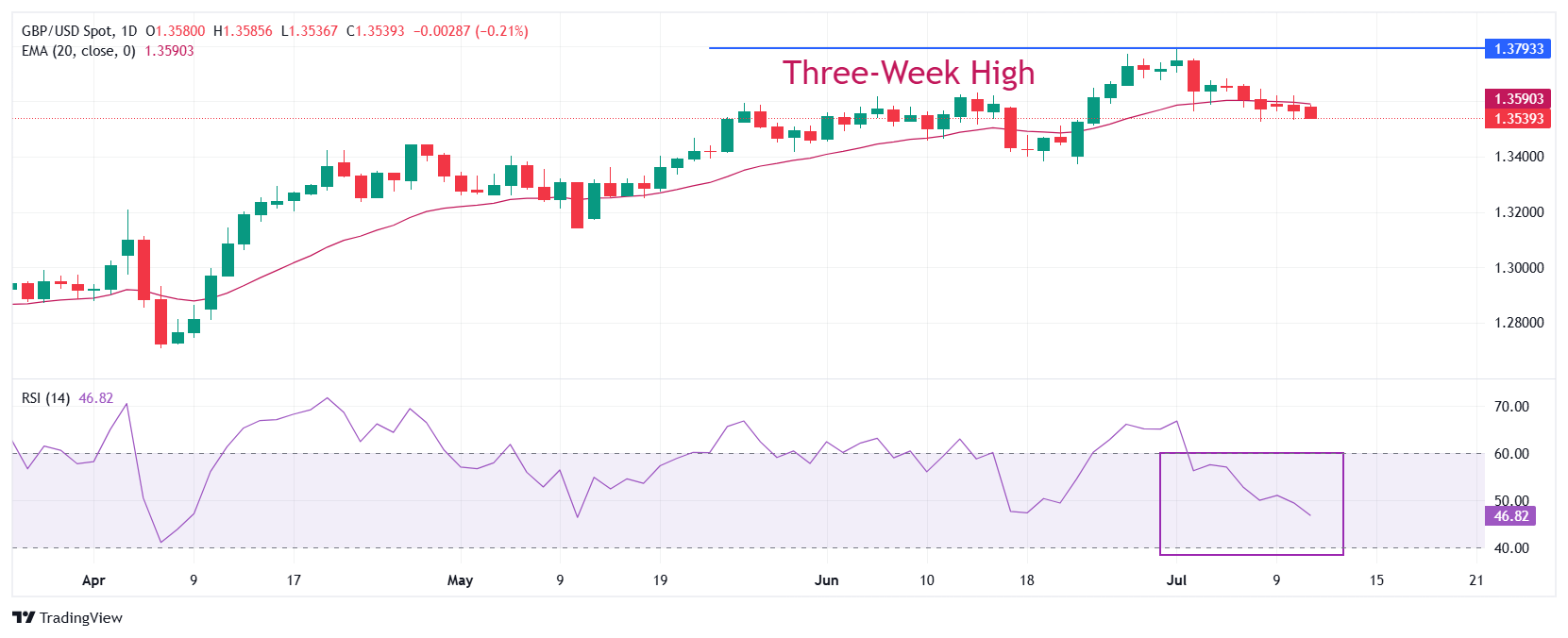- The sterling pound quotes down against its main peers, since the GDP of the United Kingdom unexpectedly decreased 0.1% in May.
- The president of the USA, considers increasing general tariffs from 10% to 15% or 20%.
- Investors focus their attention on US CPI data and the United Kingdom for June next week.
The sterling pound (GBP) faces sales pressure in front of its peers on Friday after the publication of weak data of the Gross Domestic Product (GDP) and the Industrial Production of the United Kingdom (UK) for May. The National Statistics Office (ONS) reported that the economy of the United Kingdom contracted 0.1% in the month, compared to the expectations of an expansion of 0.1%.
In April, the GDP of the United Kingdom contracted 0.3%, extending the decrease in economic activity per second consecutive month.
The poor performance of the industrial sector was one of the reasons behind economic contraction, according to the ONS data. Monthly industrial production fell at a faster rate of 0.9% compared to the fall of 0.6% observed in April. Economists expected industrial production to remain flat. In the month, manufacturing production contracted 1%, faster than 0.1%estimates and the previous reading of 0.7%.
The fall of the GDP of the United Kingdom and industrial production is expected to increase the expectations of the market that the Bank of England (BOE) could reduce rates Of interest in the August policy meeting, a scenario that is theoretically unfavorable for the British currency.
Looking ahead, the next important triggers for the sterling pound will be the data of the consumer price index (CPI) of the United Kingdom for June and employment data for the three months that end in May, which will be published next week.
Investors will pay close attention to labor market data, since BOE officials, including Governor Andrew Bailey, have warned about employment risks due to the increase in employers’ contribution to the Social Security scheme, which entered into force in April. Weak employment data would cause even more market expectations that the BOE could reduce interest rates in the policy meeting next month.
Meanwhile, the tax risks for the United Kingdom are still high since the announcement of an increase in the social spending invoice. Last week, the Foreign Minister of the Exchequer increased the standard allocation for the Universal Credit (UC), a movement that led to a sharp increase in the yields of the government bonds and weighed on the sterling pound. The announcement of an increase in the social spending invoice is intended to expand the financial burden of the United Kingdom in 4.8 billion pounds for fiscal year 2029-2030.
What moves the market today: the subinde sterling pound against the US dollar
- The sterling pound reaches a new minimum of more than two weeks about 1,3530 against the US dollar (USD) on Friday. The GBP/USD torque quotes down in weak data of the United Kingdom monthly GDP for May and a feeling of the negative market.
- The demand for risky assets, such as the sterling pound, has decreased since the president of the United States (USA) Donald Trump expressed his intentions to increase the general tariff for nations that failed to reach an agreement during the 90 -day reciprocal tariff pause period. “We simply say that all the remaining countries will pay, either 20% or 15%. We will solve it now,” Trump said in a telephone interview with NBC News on Thursday. In the so -called “Liberation Day” on April 2, Trump announced a 10% general lien for all US commercial partners, separated from reciprocal tariffs and additional sector rights.
- President Trump has also imposed 35% tariffs on Canada, one of Washington’s main business partners, and has threatened to send a letter to the European Union (EU), specifying tariff rates.
- The new tariff threats of President Trump have led to an increase in the demand for safe refuge assets. Meanwhile, the US dollar index (DXY), which tracks the value of the dollar against six main currencies, recovers a maximum of two weeks around 97.90.
- As for the US economic calendar, investors expect the US CPI data for June, which will be published on Tuesday. Inflation data will probably show the impact of sector tariffs, which will influence market expectations on the monetary policy of the Federal Reserve (FED). Currently, the markets are almost sure that the Fed will maintain interest rates in the range of 4.25% -4.50% at the policy meeting at the end of this month, according to the CME Fedwatch tool.
Technical Analysis: The sterling pound falls towards 1,3370

The sterling pound falls about a minimum of two weeks around 1,3540 in front of the US dollar on Friday. The GBP/USD torque is quoted below the 20 -day exponential (EMA) mobile average, which is around 1,3590, which suggests that the short -term trend is bassist.
The 14 -day relative force (RSI) index falls below 50.00. A new bearish impulse would arise if the RSI continues to decrease and break below 40.00.
Looking down, the minimum of June 23, 1,3370 will act as a key support zone. On the positive side, the maximum of three and a half years around 1,3800 will act as a key barrier.
Economic indicator
Gross Domestic Product (MOM)
The gross domestic product published by National Statistics It is a measure of the total value of all goods and services produced by the United Kingdom. GDP is considered as a broad measure of the economic activity of the United Kingdom. In general terms, an upward trend has a positive effect on the sterling pound, while a decreasing trend is seen as negative (or bassist).
Read more.
Last publication:
Old Jul 11, 2025 06:00
Frequency:
Monthly
Current:
-0.1%
Dear:
0.1%
Previous:
-0.3%
Fountain:
Office for National Statistics
Source: Fx Street
I am Joshua Winder, a senior-level journalist and editor at World Stock Market. I specialize in covering news related to the stock market and economic trends. With more than 8 years of experience in this field, I have become an expert in financial reporting.







